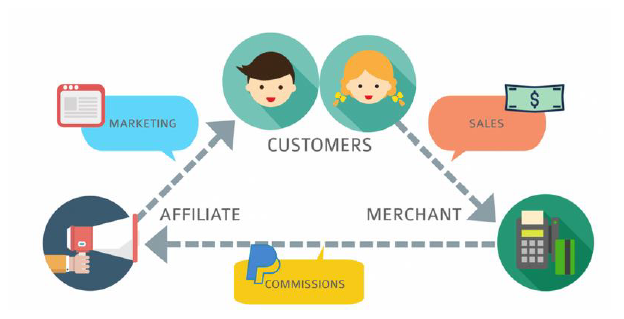Affiliate Marketing for Beginners
Affiliate marketing is a performance-based marketing technique in which businesses (merchants) compensate individuals or other businesses (affiliates) for directing traffic or sales to the merchant’s products or services via the affiliate’s marketing efforts. It works on a revenue-sharing model, with affiliates earning a commission for each sale, click, or lead produced by their promotional efforts.
Key Components
- Merchants: Companies or individuals trying to promote their products or services.
- Affiliates: Individuals or entities collaborating with merchants to promote their wares.
- Consumers: Affiliates’ target demographic for making purchases or taking desired actions.
Affiliate marketing is largely accomplished through the use of various online platforms, including websites, social media, email marketing, and other digital channels. The idea is that affiliates promote products/services and receive a commission based on the results of their efforts. It’s a win-win situation for merchants and affiliates, and it helps consumers identify relevant products/services through personalized suggestions.
Table of Contents

History and Evolution
Affiliate marketing has its origins in the mid-1990s, when William J. Tobin trademarked the concept of affiliate marketing on the internet. The introduction of the World Wide Web provided new opportunities for firms to directly approach consumers. With the advent of e-commerce and internet advertising, the concept gained traction.
Early affiliate programs were simple and frequently functioned through referral links or codes, with affiliates earning a commission on sales generated by their unique links. Amazon’s Associates Program, which debuted in 1996, was instrumental in popularizing affiliate marketing by enabling website owners to advertise and receive rewards on Amazon sales.
Affiliate marketing has expanded dramatically over time, embracing modern tracking technologies, sophisticated analytics, and a variety of commission arrangements. The emergence of social media platforms, influencer marketing, and affiliate networks further transformed the scene, providing a wealth of opportunities for merchants and affiliates to collaborate and monetize their online presence.
Importance in the Digital Era
Affiliate marketing is extremely important in today’s digital landscape for a variety of stakeholders, including:
- Diversified Revenue Streams: It enables affiliates, bloggers, influencers, and content creators to monetize their online presence by providing a lucrative income stream.
- Cost-Effective Marketing: Affiliate marketing provides merchants with a cost-effective approach to reach a larger audience without the overhead costs associated with traditional advertising.
- Performance-Based Model: Because it is performance-based, merchants only pay for actual outcomes, making it a low-risk marketing strategy when compared to traditional advertising strategies.
- Enhanced Customer Reach and Engagement: Affiliate marketing enables merchants to access highly focused audiences and boost engagement with potential customers by leveraging multiple channels and affiliate partnerships.
- Adaptability and Scalability: Its adaptability and scalability make it a versatile marketing strategy appropriate for firms of all sizes.
Affiliate marketing continues to play a critical role in increasing sales, growing brand exposure, and building mutually advantageous connections between merchants, affiliates, and consumers in the digital era, where online presence and consumer engagement are important.
How Affiliate Marketing Works
A. Key Players’ Roles (Merchants, Affiliates, and Customers)

Merchants
- Product/Service Providers: Merchants are companies or individuals that want to promote their products or services.
- Provide Affiliate Programs: They develop affiliate programs that pay affiliates commissions or benefits for marketing their products.
- Offer Marketing Materials: Affiliates are given promotional resources such as banners, links, and tracking tools by merchants.
Affiliates
- Promoters: Individuals, publishers, influencers, or enterprises who work with merchants to promote their products/services are known as affiliates.
- Promotional Activities: Affiliates employ multiple channels (websites, social media, email) to market the merchant’s offerings to their audience.
- Earn Commissions: They receive commissions or benefits for the traffic or conversions they generate based on the agreed-upon terms (sell, lead, click).
Consumers
- Target Audience: Consumers are the people or groups that affiliates target with their marketing activities.
- Make Purchases or Take Actions: Consumers interact with affiliate-promoted content and, if interested, make purchases, sign up for newsletters, or complete desired actions on the merchant’s platform.
B. Affiliate Marketing Models
- Pay-Per-Sale (PPS): Affiliates earn a percentage on every sale made through their referral link or promotional efforts in this arrangement.
Example: When a buyer purchases using their unique affiliate link, the affiliate receives a percentage of the selling price.
- Pay-Per-Lead (PPL): Affiliates are paid commissions based on the leads they produce for the merchant, which are typically generated through form submissions, sign-ups, or trials.
Example: An affiliate gets paid a set fee for each visitor who joins up for a free trial or completes a contact form.
- Pay-Per-Click (PPC): Affiliates are paid a commission depending on the number of clicks their affiliate link receives, regardless of whether the click results in a sale or conversion.
Example: Affiliates are compensated a certain sum for each click that leads a user to the merchant’s website, independent of subsequent actions.
Each model has its own set of benefits and is appropriate for a variety of products, services, and affiliate marketing techniques.
C. Steps Involved in Affiliate Marketing
Choosing a Niche and Platform
- Determine a specialty or industry that is compatible with your hobbies and target audience.
- Choose a platform to promote affiliate products/services (blog, website, social media).
Joining Affiliate Programs or Networks
- Investigate and join appropriate affiliate programs or networks.
- Merchants’ marketing materials and unique affiliate links are available.
Creating Valuable Content
- Create high-quality material (blog posts, reviews, and videos) that is relevant to the niche and affiliate offerings.
- Integrate affiliate links into the article naturally.
Promoting Affiliate Links
- Distribute content through your preferred marketing channels (social media, email, and SEO).
- Use SEO strategies to increase visibility and organic traffic.
Tracking and Analyzing Performance
- Track clicks, conversions, and revenues using tracking technologies supplied by merchants or third-party platforms.
- Analyze performance indicators to improve strategy and achieve better results.
Optimizing and Scaling
- Refine strategies in light of performance data.
- Scale successful campaigns and look for additional growth opportunities.
Understanding and actively participating in these processes is critical for successful affiliate marketing, allowing both affiliates and merchants to reap the most benefits from the collaboration.
Choosing Profitable Niches and Products

A. Researching Profitable Niches
Understanding Personal Interests and Expertise
- Begin by thinking about areas of personal interest, knowledge, or experience.
- Examine hobbies, passions, or sectors where there is extensive expertise or a strong desire to learn.
Market Research and Analysis
- Conduct extensive market research with tools like as Google Trends, SEMrush, or Ahrefs.
- Determine hot themes, new industries, or areas with rising demand.
Assessing Profitability and Competition
- Assess the profitability of potential niches by analyzing competition and demand.
- Look for underserved or less competitive areas with a large enough readership to justify your investment.
Narrowing Down Niche Selection
- Consider characteristics such as audience size, purchasing behavior, and competition intensity when narrowing down your niche choices.
- Ascertain if the chosen niche is compatible with long-term sustainability and growth potential.
B. Identifying High-Converting Products/Services
Researching Products/Services
- Investigate products or services in your selected niche that address specific consumer demands or pain points.
- Consider products or services that are in great demand and have the potential for recurring purchasing.
Evaluating Product Relevance and Quality
- Ensure that the products/services are relevant to the niche and provide actual value to the target audience.
- To determine quality and consumer happiness, look at product reviews, testimonials, and ratings.
Assessing Profitability and Commission Structure
- Examine the commission rates that retailers give for their affiliate programs.
- Consider products/services with high potential earnings per conversion and competitive commissions.
Choosing Diverse Product Range
- To appeal to varying consumer preferences, choose a diverse variety of products/services inside the niche.
- To diversify profits potential, balance high-ticket items with lower-priced things.
C. Evaluating Affiliate Programs and Networks
Researching Affiliate Programs
- Investigate affiliate networks such as ShareASale, CJ Affiliate, and Amazon Associates.
- Investigate specific merchant programs or standalone affiliate programs inside these networks.
Analyzing Program Terms and Conditions
- To ensure transparency and fairness, go over program agreements, commission structures, and payment periods.
- Look for programs that have dependable tracking mechanisms and cookie durations that are beneficial to affiliates.
Considering Affiliate Support and Resources
- Examine the level of assistance, training, and resources offered by affiliate programs.
- Select programs that provide marketing materials, dedicated affiliate managers, or useful affiliate tools.
Checking Reputation and Reliability
- Seek reviews and testimonials from other affiliates to learn about the reputation and dependability of affiliate programs.
- Programs having a track record of regular payments and fair dealings should be prioritized.
Aligning Program Values with Your Brand
- To preserve authenticity and credibility with your audience, use affiliate programs that correspond with your brand’s principles and ethics.
Affiliates can make informed selections in picking profitable niches, high-converting products/services, and dependable affiliate programs by completing rigorous research and analysis while taking personal interests, market trends, and program characteristics into account.
Building a Successful Affiliate Marketing Strategy
A. Creating a Platform (Blog, Website, Social Media)
Blog/Website Creation
- Create a professional, user-friendly blog or website centered on the specified niche.
- Choose a domain name, hosting platform, and design that will appeal to your target audience.
Social Media Presence
- Create a significant presence on relevant social media channels (such as Facebook, Instagram, and YouTube).
- Tailor content and interaction techniques to the characteristics and audience of each platform.
Platform Optimization
- Improve the platform’s user experience (UX) and search engine visibility.
- For increased engagement, use responsive design, fast loading times, and easy navigation.
Content Calendar and Consistency
- Create a content calendar that details frequent changes and publishing dates.
- Maintain consistency in your content distribution to keep your audience engaged and trusting you.
B. Content Creation Strategies (SEO, Blog Posts, Reviews, Tutorials)
SEO Optimization

- Conduct keyword research to uncover appropriate niche-related keywords.
- Improve search engine exposure by optimizing content (titles, meta descriptions, and headings) using chosen keywords.
Informative Blog Posts
- Create relevant and helpful blog posts that address the needs, concerns, or interests of your readers.
- Integrate affiliate links into the material naturally, focusing on providing value rather than hard selling.
Product Reviews and Recommendations
- Create informative, unbiased product/service reviews that highlight benefits, features, and disadvantages.
- Make real recommendations that are supported by personal experiences or extensive study.
Educational Tutorials and How-To Guides
- Create tutorials, guides, or how-to information that shows how to use or benefits from products/services.
- Include step-by-step directions or video demos to help the audience understand what you’re saying.
C. Utilizing Email Marketing and Funnels
Building Email Lists
- Set up opt-in forms or lead magnets on your website to collect email addresses.
- In exchange for email subscribers, provide useful incentives (e-books, courses, special material).
Segmentation and Personalization
- For targeted communication, segment email lists based on interests, behavior, or demographics.
- Personalize emails to appeal to certain segments, such as delivering targeted product recommendations or information.
Email Sequences and Funnels
- To nurture leads and boost conversions, create email sequences or automated funnels.
- Create interesting content sequences, beginning with welcome emails and progressing to product advertisements or instructive courses.
Call-to-Action (CTA) Optimization
- Include clear and appealing CTAs in emails to guide subscribers to desired actions.
- Experiment with various CTAs and optimize according to performance metrics.
Continuous monitoring, testing, and revision based on analytics and audience input are required for effective implementation of these tactics. Combining multiple content production strategies with a strong platform and focused email marketing can dramatically boost the success of an affiliate marketer.
Effective Techniques for Affiliate Promotion
A. Utilizing Various Marketing Channels (Social Media, SEO, PPC)
Social Media Marketing
- Content Strategy: Make compelling and shareable material for each network (Facebook, Instagram, Twitter, and so on).
- Engagement and Community Building: Develop relationships, interact with followers, and create a community around the specialty.
- Promotion Techniques: To promote affiliate links, deals, and content, use both paid and organic tactics.
Search Engine Optimization (SEO)
- Keyword Optimization: Improve organic search visibility by optimizing content with relevant keywords.
- Quality Content Creation: Create high-quality, valuable content that corresponds to user search intent.
- Link Building: Create high-quality backlinks from trusted sites to boost your website’s authority and rating.
Pay-Per-Click Advertising (PPC)
- Targeted Ad Campaigns: Create focused PPC campaigns using platforms such as Google Ads or Bing Ads.
- Keyword Targeting: Use keywords that are specific to the niche and products/services being promoted.
- Ad Copy Optimization: Create compelling ad copy that encourages clicks and conversions.
B. Leveraging Influencer Partnerships
Identifying Relevant Influencers
- Investigate and find influencers in the niche whose audience is similar to the target market.
- Consider micro-influencers with large followings for more targeted promotion.
Establishing Partnerships
- Contact influencers with personalized approaches that highlight the mutual benefits of collaboration.
- To form a mutually advantageous collaboration, negotiate conditions such as commission rates or remuneration.
Co-Creating Content
- Collaborate with influencers to generate authentic and compelling content for their audience.
- Integrate affiliate links or promotional codes into their material.
Tracking and Performance Analysis
- Track the performance of influencer-driven initiatives using tracking tools or affiliate systems.
- To assess the efficiency of influencer collaborations, examine data such as clicks, conversions, and ROI.
C. Crafting Compelling Calls-to-Action
Clarity and Relevance
- Ensure that CTAs are clear, simple, and relevant to the content and demands of the audience.
- Use actionable language that encourages instant action (for example, “Buy Now,” “Learn More,” or “Subscribe”).
Placement and Visibility
- CTAs should be strategically placed on web sites or in content where they are highly noticeable.
- Experiment with different places to find the most effective CTA positioning.
Urgency and Persuasion
- In CTAs, use limited-time offers or exclusive discounts to create a sense of urgency.
- Use persuasive language that stresses the importance or advantages of taking the desired action.
Testing and Optimization
- A/B test different CTA versions to see which ones produce the best results.
- Improve conversion rates by continuously optimizing CTAs based on performance data.
Implementing these effective promotion strategies necessitates a deliberate mix of marketing channels, influencer alliances, and the creation of appealing CTAs suited to the audience’s tastes and behavior. Regular performance-based analysis and adaptation are critical for refining and maximizing the effectiveness of these techniques.
Tracking and Optimizing Performance
A. Importance of Analytics and Tracking Tools
Data-Driven Decision Making
- Analytics and tracking technologies provide useful information about the effectiveness of affiliate marketing efforts.
- They provide information on traffic sources, conversions, click-through rates, and other important indicators.
Understanding Audience Behavior
- Tracking tools aid in gaining an insight of how users engage with content and affiliate links.
- Detailed analytics demonstrate which strategies or channels are more popular with the target audience.
ROI Measurement
- Analytics make it possible to calculate the return on investment (ROI) for various campaigns.
- They aid in determining the profitability and effectiveness of various promotional initiatives.
Improving Campaign Effectiveness
- Marketers can discover under performing areas and make required improvements to optimize campaigns by examining data.
Tracking Affiliate Performance
- Tracking tools aid in the monitoring of individual affiliate performance, allowing for the identification of top-performing affiliates and the appropriate compensation.
B. Split Testing and Optimization Strategies
A/B Testing
- Run A/B tests on various aspects like as headlines, call-to-action buttons, and content layouts.
- Compare performance metrics to see which variations produce the best outcomes.
Optimizing Landing Pages
- Continuously optimize landing pages by experimenting with different styles, content, and affiliate link placement.
- Implement modifications that increase conversion rates and user engagement.
Testing Different Offers and Incentives
- Experiment with different offers, discounts, or incentives to see how they affect conversions.
- Determine which offers resonate the most with the audience in order to increase conversions.
Segmentation and Targeting
- Segment the audience depending on factors such as demographics, behavior, and interests.
- To boost relevance and engagement, tailor campaigns to certain segments.
Regular Performance Analysis
- Analyze performance indicators on a regular basis to identify trends, patterns, and opportunities for improvement.
- Changes should be implemented based on data-driven insights to improve overall campaign efficacy.
C. Scaling Successful Campaigns
Identifying High-Performing Campaigns
- Determine which initiatives consistently produce outstanding outcomes in terms of conversions, ROI, or engagement.
Increasing Reach and Investment
- Increase the resources, funding, or effort put into successful campaigns in order to expand their influence.
- Increase reach by utilizing more marketing channels or investing in more effective tactics.
Expanding Affiliate Partnerships
- Develop relationships with top-performing affiliates or influencers and look for ways to collaborate to grow successful campaigns.
Automation and Streamlining Processes
- To handle greater growth efficiently, automate repetitive tasks and streamline processes.
- Use tools or technologies that allow for scalability while not sacrificing quality or performance.
Continuous Monitoring and Adaptation
- Even if a campaign is a success, continue to analyze performance and modify methods to changing market trends or audience preferences.
Affiliate marketers may continually improve performance, maximize ROI, and sustain long-term success in affiliate marketing by creating comprehensive tracking methods, utilizing optimization strategies, and efficiently scaling successful programs.
Challenges and Solutions in Affiliate Marketing
A. Dealing with Competition
- Saturated Markets
Challenge
It might be difficult for beginners to distinguish out in prominent sectors due to fierce competition.
Solution
Focus on niche differentiation by focusing in distinct views or items within the larger market.
- Rising Costs and Bidding Wars
Challenge
Increased competition may raise advertising prices, particularly in PPC campaigns.
Solution
Rather than bidding on generic or highly competitive keywords, diversify marketing channels, focus on long-tail keywords, and optimize campaigns for greater ROI.
- Staying Updated with Trends
Challenge
Keeping up with quickly changing industry trends and customer behavior can be difficult.
Solution
Research and remain current on industry trends, consumer preferences, and emerging technology on a regular basis. Be adaptable and alter your strategies as needed.
B. Avoiding Common Pitfalls and Mistakes

Over-Promotion or Hard Selling
- Pitfall
Overloading consumers with promotional content may result in decreased trust and engagement. - Solution
Focus on giving value, balancing promotional content with instructive, instructional, or amusing information, and refraining from aggressive sales approaches.
Choosing Quantity over Quality
- Pitfall
Focusing primarily on producing large amounts of material without guaranteeing its quality can jeopardize credibility. - Solution
Rather than quantity, prioritize quality content that resonates with the audience, addresses their requirements, and provides important insights.
Ignoring Compliance and Disclosure
- Pitfall
Failure to disclose affiliate ties or comply with advertising standards might result in legal consequences and undermine confidence. - Solution
Always follow FTC requirements by explicitly disclosing affiliate ties in material via proper labeling or disclaimers, providing audience openness.
C. Regulatory Compliance and Ethical Practices
Navigating Legal Regulations
- Challenge
Observing various legal requirements, such as privacy regulations, disclosure guidelines, and advertising standards in different locations. - Solution
Keep up to date on regulatory developments, obtain legal counsel as needed, and ensure compliance with local and international laws and rules.
Ethical Considerations
- Challenge
Maintaining authenticity and credibility while balancing affiliate marketing aims with ethical approaches. - Solution
Honesty, transparency, and integrity should be prioritized in all promotions. Recommend products/services in which you have real faith and declare any biases or conflicts of interest.
Ensuring Fair and Transparent Practices
- Challenge
Unfair techniques, such as cookie stuffing, false promises, or unethical promotional strategies, can ruin a company’s reputation and breach regulations. - Solution
Maintain ethical standards by focusing on honest and truthful product/service depiction, avoiding fraudulent techniques, and preserving audience trust.
To retain credibility and create long-term relationships with both audiences and industry stakeholders, addressing these problems in affiliate marketing requires a combination of strategic methods, ethical considerations, and a dedication to openness and compliance with rules.
Future Trends in Affiliate Marketing
A. Emerging Technologies (AI, AR, VR)
Artificial Intelligence (AI)

Personalization
AI-powered algorithms improve user behavior understanding, enabling for personalized suggestions and content delivery.
Predictive Analytics
AI can forecast customer preferences and trends, assisting in focused marketing efforts that result in increased conversions.
Chatbots and Automation
AI-powered chatbots help with customer interactions, answering questions, and directing users to purchases.
Augmented Reality (AR) and Virtual Reality (VR)
Enhanced Shopping Experiences
AR and VR technology enable immersive experiences that allow clients to virtually test things before purchasing them.
Interactive Content
AR/VR in content marketing is used to produce engaging and interactive promotional material, increasing user engagement and brand loyalty.
Voice Search and Assistants
Voice-Activated Commerce
Voice search and assistants such as Siri, Alexa, and Google Assistant will have an impact on how customers search for and purchase things, affecting SEO and content strategy.
B. Changing Consumer Behavior and Expectations
Shift to Mobile and Omni-Channel Shopping
Mobile-Centric Approach
Mobile shopping continues to rise, driving marketers to optimize for mobile-first experiences.
Omni-Channel Integration
Consumers want a consistent buying experience across all channels (online, mobile, and in-store), therefore affiliate marketing strategies must fit with multi-channel techniques.
Preference for Authenticity and Transparency
Trust and Transparency
Consumers expect companies and affiliates to be transparent, and they value authenticity and ethical marketing methods.
User-Generated Content (UGC)
Utilizing UGC as social proof is becoming increasingly important in influencing purchasing decisions.
Focus on Sustainability and Social Responsibility
Ethical Considerations
Consumers are increasingly favoring brands that promote sustainability and social responsibility, which influences affiliate partnerships and product recommendations.
C. Predictions and Forecasts
Rise of Niche Influencers and Micro-Influencers
Increased reliance on specialized influencers or micro-influencers with highly engaged followers, with a preference for authenticity and tailored promotions.
Video Content Dominance
Increased consumption of video content, prompting affiliate marketing tactics to include more video-centric content for product advertising and reviews.
Further Advancements in Personalization
AI and data-driven insights enable enhanced personalization, enabling for hyper-targeted promotions and tailored customer experiences.
Evolution of Affiliate Networks and Platforms
Affiliate networks and platforms are adapting to new technology, which improves tracking, reporting, and analytics for affiliates and merchants.
Staying ahead in the affiliate marketing landscape needs adaptation, a customer-centric approach, and an embrace of technical improvements to suit evolving consumer habits and expectations. Adopting these future trends helps that marketers remain competitive and effectively communicate with their audiences in the ever-changing digital landscape.
Case Studies and Success Stories
A. Real-Life Examples of Successful Affiliate Marketers
- Pat Flynn (Smart Passive Income)
Pat Flynn began with a specialty website and expanded into several revenue streams, with affiliate marketing playing a big role.
Strategy
He focuses on giving value by promoting things he personally uses and believes in through educational material, product reviews, and tutorials.
Success
His open and honest approach earned him a loyal fanbase and substantial affiliate profits.
- Michelle Schroeder-Gardner (Making Sense of Cents)
Michelle monetized her personal finance blog through affiliate marketing by sharing her path of debt repayment and financial independence.
Strategy
She stresses authenticity by suggesting only things she believes in, which are accompanied by in-depth reviews and effective recommendations.
Success
Michelle’s open and relatable material connects with her audience, resulting in significant affiliate revenue.
- John Chow (John Chow dot Com)
John Chow used his blog to become one of the best affiliate marketers by sharing his internet marketing expertise and experiences.
Strategy
To promote affiliate items, he uses a combination of content marketing, email marketing, and social networking.
Success
To grow affiliate sales, John focuses on creating relationships, cultivating a community, and continually offering valuable material.
B. Analysis of Strategies and Tactics Used
Content Quality and Relevance
All successful affiliate marketers focus high-quality, relevant content that meets the needs of their target audience.
Comprehensive evaluations, tutorials, how-to instructions, and personal tales that resonate with the audience are all part of the strategy.
Authenticity and Trust Building
Transparency and honesty in product promotion foster audience trust and credibility.
A devoted following can be built by avoiding pushy sales approaches and focusing on giving value.
Diversification and Testing
Successful marketers diversify their revenue streams and test new strategies, channels, and product offerings on a regular basis.
To maximize results, they adjust and modify based on data and audience response.
Relationship Building and Community Engagement
Building a close relationship with the audience and actively connecting with them across several media promotes a feeling of community.
Participating in audience comments, emails, and social media engagements builds a devoted and engaged audience base.
C. Lessons Learned and Applicable Takeaways
Value-Driven Approach
- Instead of focusing simply on sales, prioritize offering value and solving audience concerns.
- Audiences respond better to authenticity, honesty, and genuine recommendations.
Consistency and Persistence
- Long-term success requires consistency in content creation, testing methodologies, and engagement.
- Affiliate marketing success is generally achieved gradually, necessitating perseverance and attention.
Adaptability and Innovation
- Be adaptable and receptive to new technologies, trends, and strategies in the ever-changing digital landscape.
- To stay ahead in the competitive affiliate marketing field, innovate and experiment with new ways.
Relationships Matter
- Building good relationships with your audience, affiliates, and sponsors is essential for long-term success.
- Participating in the community and giving excellent customer service builds trust and loyalty.
Studying the techniques and tales of successful affiliate marketers provides useful insights and actionable takeaways for budding marketers. The emphasis on value, authenticity, connection development, and adaptability serves as a road map to success in the competitive world of affiliate marketing.
Conclusion
A. Recap of Key Points
It is a performance-based model in which affiliates earn commissions for recommending merchant products/services. Merchants provide products/services, affiliates market them, and customers buy through affiliate links. To thrive in affiliate marketing, prioritize niche selection, quality content production, and ethical advertising. Deal with competition, avoid frequent errors, follow regulations, and adjust to changing trends. For long-term success, embrace evolving technology, cater to changing consumer preferences, and anticipate industry forecasts.
B. Encouragement and Advice for Aspiring Affiliate Marketers
To aspiring affiliate marketers:
- Start with Passion: Choose a niche in which you are interested to keep interest and authenticity in your promotions.
- Education and Learning: Spend time learning about and staying current on industry trends, strategies, and best practices.
- Persistence and Patience: Success does not happen overnight. Be persistent, try new things, and learn from your mistakes.
- Ethical Practices: To develop trust with your audience, prioritize honesty, transparency, and ethical promotion.
- Building Relationships: Engage your audience, cultivate relationships, and prioritize their trust above everything else.
C. Final Thoughts
Affiliate marketing has enormous potential for individuals who are ready to put in the time, effort, and attention. It’s a fast-paced industry that values innovation, adaptability, and honesty. Remember that success in affiliate marketing needs a careful balance of strategy, relationship-building, and ongoing learning.
For those considering or just getting started in affiliate marketing, now is the time to act. Begin by establishing your specialty, studying the ins and outs of affiliate marketing, and implementing methods learnt from successful affiliates. Continue to be persistent, ethical, and committed to offering value to your audience.
To summarize, affiliate marketing is more than just selling items; it is also about connecting people with solutions they need and believe in. Accept the obstacles, capitalize on the trends, and embark on your affiliate marketing adventure with zeal, passion, and a commitment to providing value.
Remember that affiliate marketing success is a journey, not a destination. Begin today to set the way for a successful and gratifying career in affiliate marketing!


